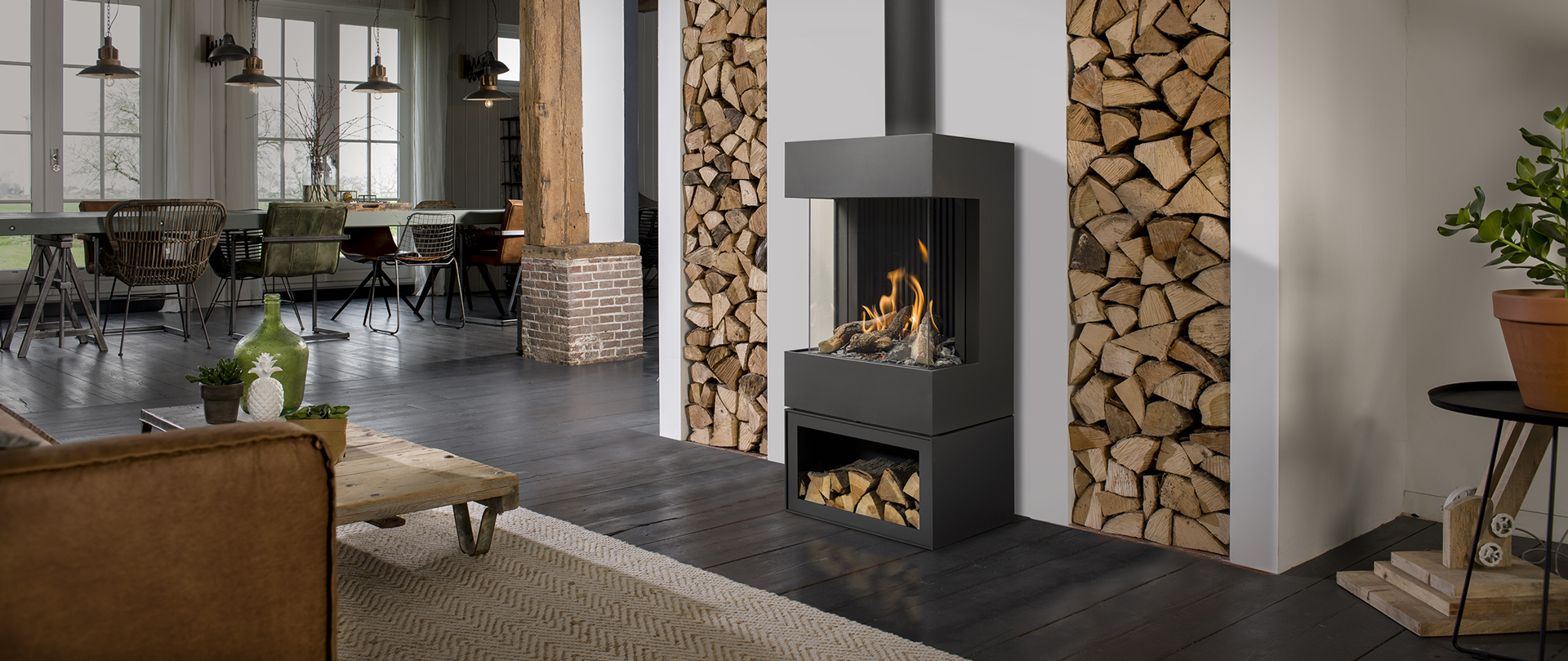There are three key options when choosing a heating source for your home: an open fire, a woodburning/multifuel stove and an artificial fire in the form of gas, electric or bio-ethanol.
Each of these options fulfils different functions and it is important to consider some of the following questions:
- Will this be your main heating appliance?
- What size is the room you are required to heat?
- Will this source be used regularly or occasionally?
- What is more important for your room – heat source, aesthetically pleasing?
- Do you have an existing chimney or flue?
- Do you have access to Natural Gas or LPG?
It is always recommended that you seek the advice from a professional Fire & Stove specialist and get a site visit before commitment.
Wood Burning/ Multifuel Stove
Advantages
1.Exceptional Heat Source –The biggest advantages of a wood-burning stove is the quality of heat the appliance gives off. Operating on the principle of radiant heat, this can warm an area faster and more efficiently than warm air being blown through a home’s vent system. The powerful heat from a wood stove radiates from all sides of the unit as well as the top, sending warmth in all directions.
A multi-fuel stove means you can burn a combination of logs, smokeless fuels or peat/turf briquettes. Multi-fuel stoves also have a riddling grate which allows ash to be collected into a built-in ashpan as these fuels burn best with air entering from beneath the fire and allowing for more efficient combustion
- Flexibility and Choice
Wood burning stoves are available in a range of different styles, sizes and finishes offering you more choice when it comes to styling your home and decor
- Better for the environment
Compared with using fossil fuels for heat (natural gas, propane, coal, etc.) wood-burning stoves are considered much more eco-friendly. It’s considered “carbon-neutral,” which means when it burns, it doesn’t add additional carbon dioxide to the environment. This is because in its natural state as a tree, wood absorbs carbon dioxide that’s in the atmosphere.
In line with the DEFRA Clean Air Strategy which is to be implemented in 2022, many of our suppliers now have designed ECO -Design ready multi-burner and wood-burning stoves which offer even more heat efficiency and are more environmentally friendly. For more info.. see here!
- Economical heating
Wood is an inexpensive fuel source and can be more cost-efficient than gas or electricity
- Works during power outages
If you experience occasional power outages throughout the winter, you know how valuable a heat source that is 100% self-contained can be. With a dependable wood stove, you’ll stay warm around the clock, regardless of your home’s supply of gas or electricity.
- Cooking convenience
An overlooked benefit of wood-burning stoves is the fact that some models double as a stovetop. With a little practice in temperature adjustment and cookware placement, you’ll find that the top surface of your wood stove is perfect for cooking and warming an endless variety of foods and meals. Check out Charnwood’s range of cooking accessories here!
Disadvantages for Wood/Multiburner Stoves
A common disadvantage for both wood burners and multi-burner stoves include extensive maintenance requirements including regular cleaning and both are required to have regular servicing to ensure ventilation is running at optimum.
Advantages of a Gas Fire
Heat Efficiencies
Capable of delivering heat outputs of up to 8kw for many living spaces, gas fires are more than enough to act as a primary source of heat.
Many gas stoves are glass-fronted, keeping as much heat in as possible. The stoves are made of materials that are good conductors of heat, including traditional cast iron and steel. Balanced flue models often have efficiencies of over 80%, making your gas stove a warming addition to the home
Cost-Effective
Gas fires can be extremely cost-effective Many homes in the UK are connected to mains supplies of Natural Gas. However, if you’re not connected there’s no problem, many can be used with LPG. Using mains gas or LPG, gas means economical heating at any time, directly where you want it. Natural Gas is particularly economical and costs less per kWh than heating oil, electricity and in many cases wood.
No Chimney/ No Problem – No chimney is required to install a balanced flue as a twin-wall pipe vents directly to an outside wall, either horizontally through an external wall or vertically through the roof, depending on the stove selected.
Clean and Convenient
Gas fires are clean and convenient with no ash residues or odours! They are easily controlled by the flip of a switch or in most cases now via remote control. Most new models come equipped with timers for greater efficiencies
Safer
Gas fires are often a safer option for homes with children or pets as there is no toxic fumes, open flames or sparks to worry about.
Flexibility and Choice
Disadvantages of Gas Fire
- The cost of installing a gas fireplace may be higher especially if a gas line needs to be installed
- Lack of ambience without crackling sounds or smell of firewood.
Benefits of an Electric Fire
- No fumes
- No chimney required
- Energy efficient
- Easy Installation
- Lot of design choice
- Safe
- Low maintenance
Disadvantages of an Electric Fire
It is unlikely to get a flame which is quite comparable to wood or gas
Allow us to help you
With so many variations of fireplaces and stoves and the widest selection of stone, slate, marble & brick finishes to choose from, complete the quick fact-finder below and our specialist team will assist you in choosing the right fireplace/ stove that will suit both aesthetically and financially.


























